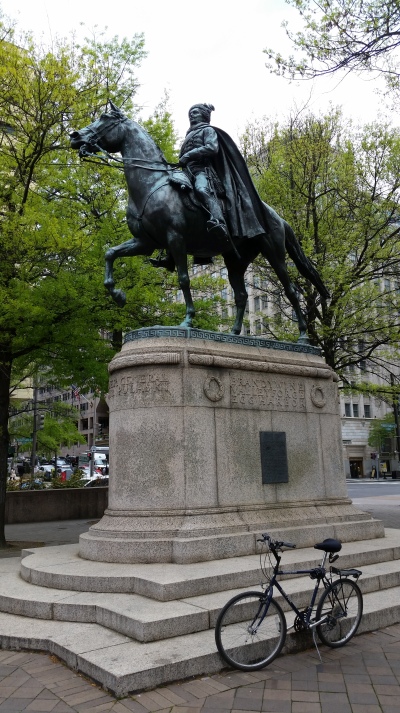Kazimierz Michał Władysław Wiktor Pułaski was born on March 6, 1745, in Warsaw, Poland, the oldest of three sons born to Count Józef Pułaski and Marianna Zielińska, who were members of the szlachta, an old and influential branch of the Polish aristocracy. Following in his father’s footsteps he became interested in politics at an early age, and soon became involved in the military and the revolutionary affairs in Poland. At the age of fifteen, he joined his father and other members of the szlachta in a conspiracy known as the Confederation of Bar, intended to free Poland from Russian and Prussian interference in Polish affairs. In 1771 the Polish government implicated Pulaski in a plot to abduct Stanislaus II, the Russian-controlled king. Accused of treason for his actions on behalf of Polish liberty, Pulaski travelled to Paris and sought protection in France. There he met Benjamin Franklin and Marquis de Lafayette, who induced him to support the colonies against England in the American Revolutionary War. Following a recommendation by Benjamin Franklin, the American ambassador to France, Pulaski emigrated to North America to help in the cause of the American Revolution, arriving in Philadelphia in 1777.
Upon his arrival Pulaski submitted his name to the Continental Congress for an officer’s commission. However, he was initially turned down. So he unofficially joined General George Washington’s forces, and after saving his life at the Battle of Brandywine, was appointed a brigadier general in the Continental Army. Later that year Pulaski went on to fight at the Battle of Germantown, and then briefly stayed at Valley Forge during the winter of 1777-78. During the following spring, he briefly resigned his commission with the intent of returning to France. After being reinstated and sent to New York, Pulaski experienced a number of setbacks and once again decided to leave America. But events in Georgia kept Pulaski in the army and brought him to the South.
Pulaski distinguished himself throughout the revolution, and of all the Polish officers who took part in the American War for Independence, Pulaski was the most prominent. Of his many accomplishments, Pulaski is best known for having created the Pulaski Cavalry Legion, and reforming the American cavalry as a whole. In fact, along with Michael Kovats de Fabriczy, they are known as the founding fathers of the American cavalry.
At the Siege of Savannah in 1779, while leading a daring charge against British forces, he was mortally wounded by British cannon shot. Pulaski’s enemies so respected him, however, that they spared him the musket and permitted him to be carried from the battlefield to the American camp. James Lynah, the physician who treated Pulaski, claimed that he could have saved him if the general had remained in the American camp. However, Pulaski insisted upon boarding a ship, and was taken aboard the Continental Brigantine Wasp. Rumors about the exact cause of death and place of burial emerged after Pulaski’s death and continue to exist, but the standard account of what happened comes from Captain Paul Bentalou, who claimed that the general died of gangrene aboard the ship and was buried at sea.
On this lunchtime bike ride I stopped by Freedom Plaza in northwest D.C., to see a bronze equestrian statue of Brigadier General Casimir Pulaski, which is located near the corner of 13th Street and Pennsylvania Avenue (MAP). The statue, by Polish sculptor Kazimierz Chodziński and Architect Albert R. Ross, shows a mounted figure of General Pulaski dressed in the uniform of a cavalry commander from his native Poland. It is part of a group of fourteen statues scattered across the city, mainly in squares and traffic circles, which are collectively known as the “American Revolution Statuary.” These statues are listed as a group on the National Register of Historic Places.
The Brigadier General Casimir Pulaski statue was dedicated on May 11, 1910. Just over 99 years later, Congress passed a joint resolution conferring honorary U.S. citizenship on Pulaski. It was sent to President Barack Obama for approval, and was signed on November 6, 2009. Pulaski is only the seventh person to receive the honor. So the man who wanted to stay in Poland but was forced to leave, became a citizen of the United States, a country which he wanted to leave but where circumstances forced him to stay. And although he failed to help lead the revolution in Poland, the statue honoring him for his participation in the American revolution depicts him wearing the uniform of Poland.


[Click on the thumbnails above to view the full size photos]

